News Take Action
Slow by Design: Making School Zones Safe Without Cameras
| Date: | March 15, 2021 |
| Share: |
As concerns about the effectiveness and fairness of the Buffalo School Zone Speed Camera continue, this post analyzes the 20 school zones where speed cameras have been installed. It assigns them into four categories based on safety risk and traffic volume, and recommends traffic-calming measures for each zone. It recommends next steps for slowing traffic in school zones by design, before turning to any punitive enforcement measures.
This post analyzes the 20 school zones where the City of Buffalo has installed speed cameras and separates them into four categories based on the average annual number of injurious traffic crashes (2015-2018) and average annual daily traffic counts (latest available data) within each zone. Recommendations are provided for how to best calm traffic in each zone, without the use of speed cameras.
The recommended traffic calming alternatives proposed here are widely accepted and used in jurisdictions worldwide, and are specifically identified by the Federal Highway Administration for implementation in the United States. This post draws on data on the City of Buffalo School Zone Speed Camera Program collected by independent researcher Peter Rizzo.
The graph below shows which school zones are located in areas of higher (top right side) and lower (bottom left side) traffic crashes and volume. Each point represents one school zone that currently has a speed camera. The full school names and specific data for each one can be found later in this post, under "School Zones with Speed Cameras."
SCHOOL ZONES BY DAILY TRAFFIC VOLUME AND NUMBER OF ANNUAL CRASHES
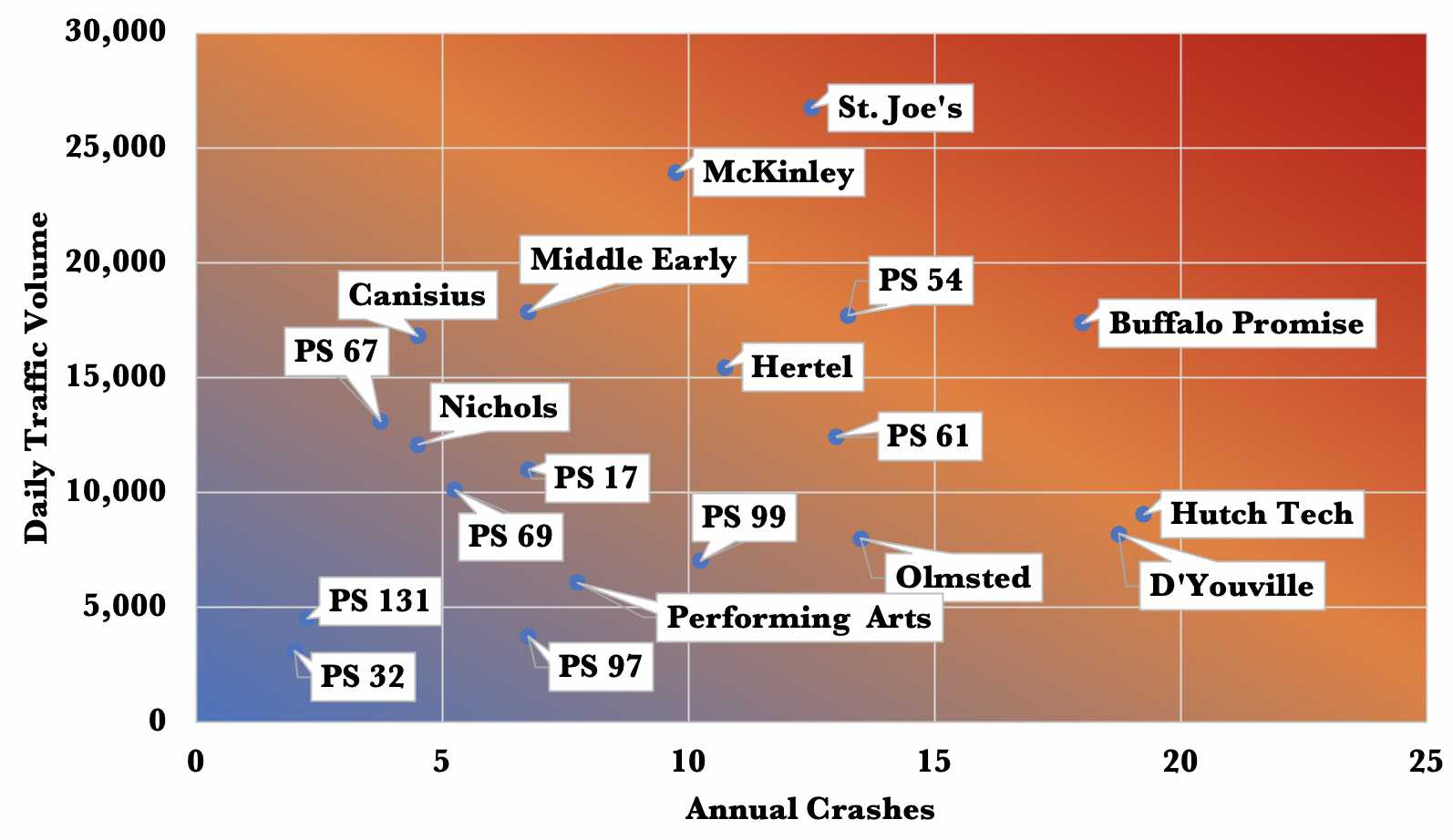
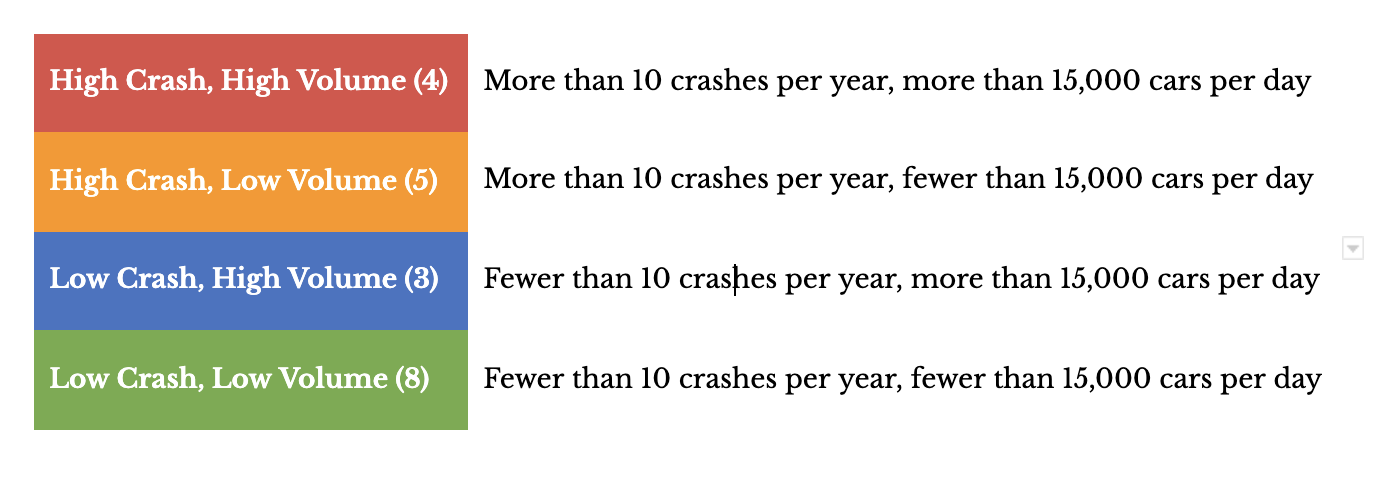
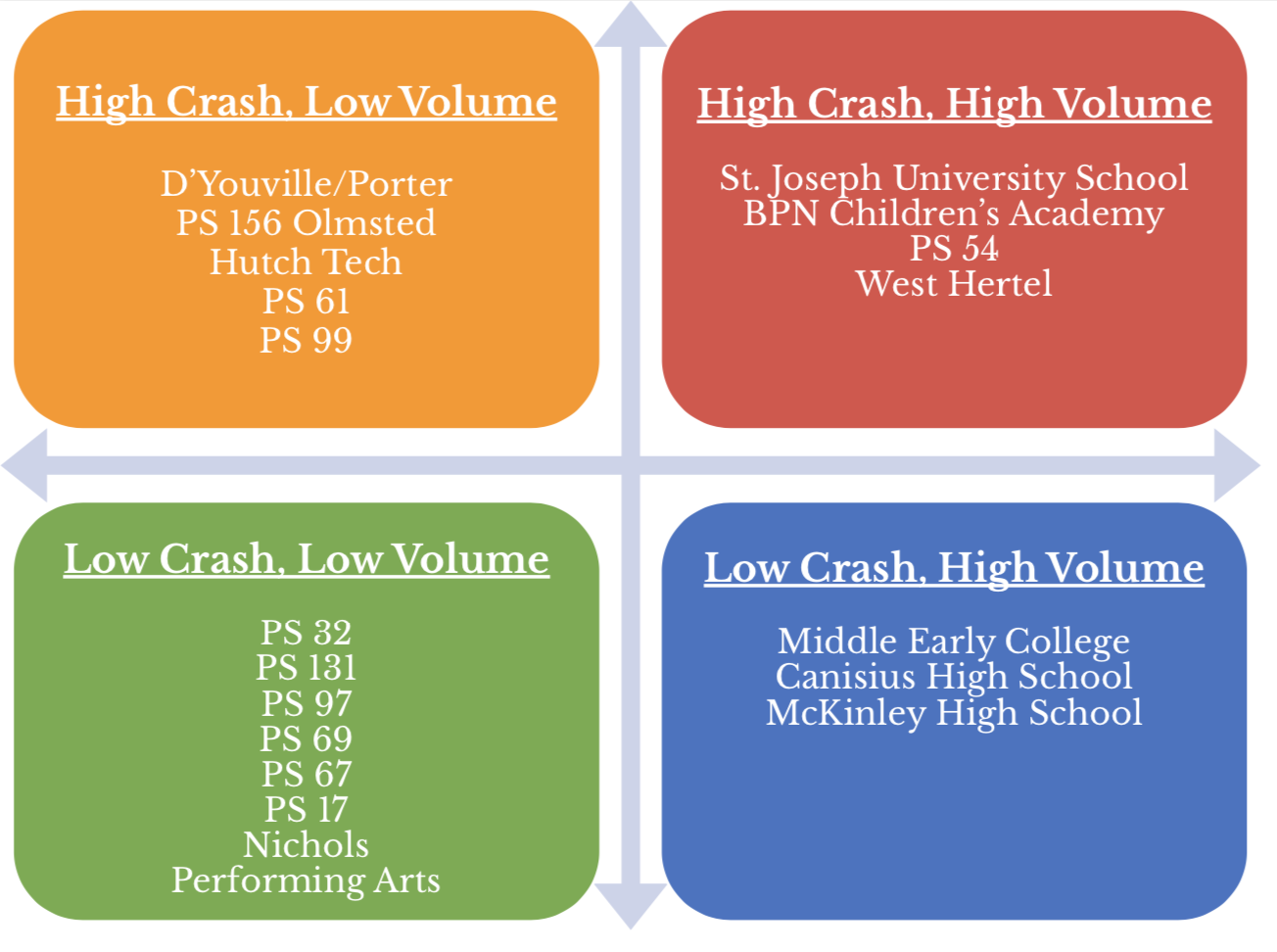
POTENTIAL TRAFFIC CALMING IMPROVEMENTS BASED ON RISK CATEGORY
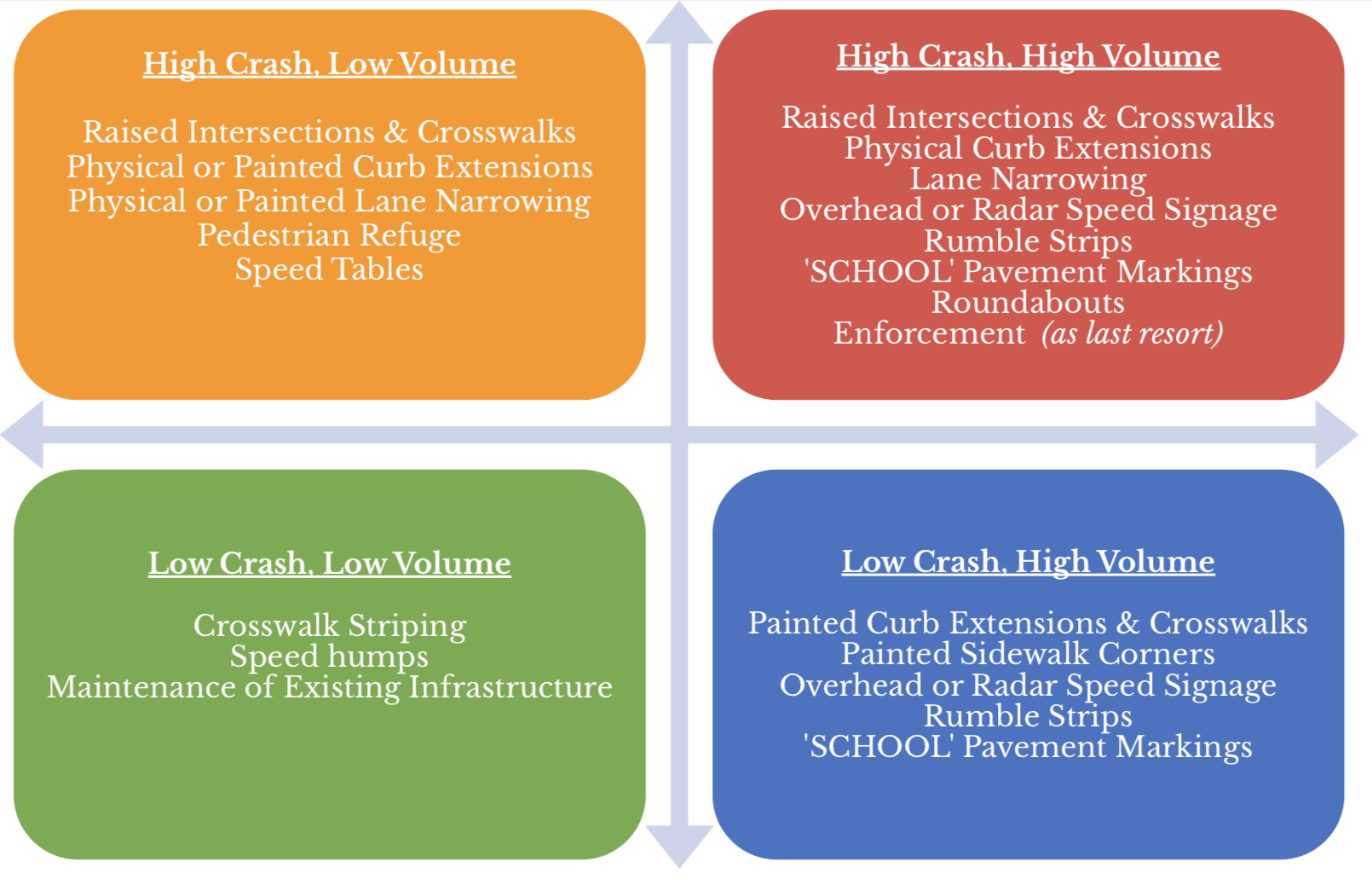
EXAMPLES OF POTENTIAL SOLUTIONS FOR EACH CATEGORY
Low Crash, Low Volume: PS 32 Bennett Park Montessori
PS 32 Bennett Park Montessori is located on a relatively quiet, two-lane residential section of Clinton Street across from a school administration building and a park with a community center. Because there is a low volume of traffic in this school zone, speed tables, raised crosswalks, or raised intersections could be appropriate for this area and would benefit users of the park and the school. However, even simple maintenance of painted crosswalks and adequate signage of the school zone might suffice to slow drivers in this area. The use of fixed speed camera enforcement in an area with so few crashes and so little traffic is unnecessary.
Low Crash, High Volume: Middle Early College
PS 335 Middle Early College is located on a busy, four-lane section of Main Street that is a mix of residential and commercial buildings. Due to the volume of traffic, a speed table or other physical change may not be the best choice for this area, but painting the speed limit in each lane going both directions, painting curb extensions, painting a bold ‘SCHOOL’ marking across all lanes or using rumble strips that make noise are all options to get drivers attention during the school day to slow down. Digital radar speed signs that alert drivers to their speed are another proven strategy for getting drivers to slow down, and are inexpensive. These measures help slow traffic during the school day, but don’t impede traffic flow during all hours. Unless speed, and not driver distraction, is demonstrated to be causing a high number of crashes even after design improvements are made, it is likely that these areas will not be appropriate for fixed camera speed enforcement.
High Crash, Low Volume: PS 156 Frederick Law Olmsted
PS 156 Frederick Law Olmsted is located on a two-lane street in a residential area, near the on and off-ramps of the NY-33 Kensington Expressway. The road is not especially wide, but it is very straight, and its proximity to the highway may be one reason why there are more crashes here. The high density of housing in the school zone makes the area a critical one for slowing traffic. Fortunately, there are a plethora of design options that could work for this area. Physical changes, including raised crosswalks, speed tables, curb extensions, or “chokers” that narrow drive lanes are all viable options. Visual changes, like painted ‘SCHOOL’ markings on the roadway surface, and noisy rumble strips that signify a slow zone are also beneficial. The options for design improvements in a zone like Olmsted are so numerous, that implementing an enforcement strategy before making design changes does not make sense.
High Crash, High Volume: Buffalo Promise Neighborhood Children’s Academy
Buffalo Promise Neighborhood Children’s Academy is located on a busy, commercial section of Bailey Avenue. In this section of Bailey, like other sections, the painted markings on the street are so faded it is difficult to discern how many lanes the street is meant to be. Bailey Avenue is wide enough in many places for four lanes of traffic; however, there is just one center dividing yellow line. The Children’s Academy is directly on an intersection of East Amherst Street and Bailey, and improving this intersection by painting clear markings and adding raised crosswalks or a raised intersection could slow traffic in this area. Much of the Bailey Avenue corridor suffers from infrastructure neglect, and basic improvements to much of the street would improve traffic safety. On wide, commercial streets where physical barriers may not be appropriate, all possible options for design improvements should be made to slow traffic before any enforcement mechanism is used. If, after design improvements are made, speed is a major contributing factor to most school-day, daytime crashes in this area, fixed speed enforcement cameras may then be appropriate.
School Zones With Speed Cameras, Sorted from High Crash-High Volume Locations to Low Crash-Low Volume Locations
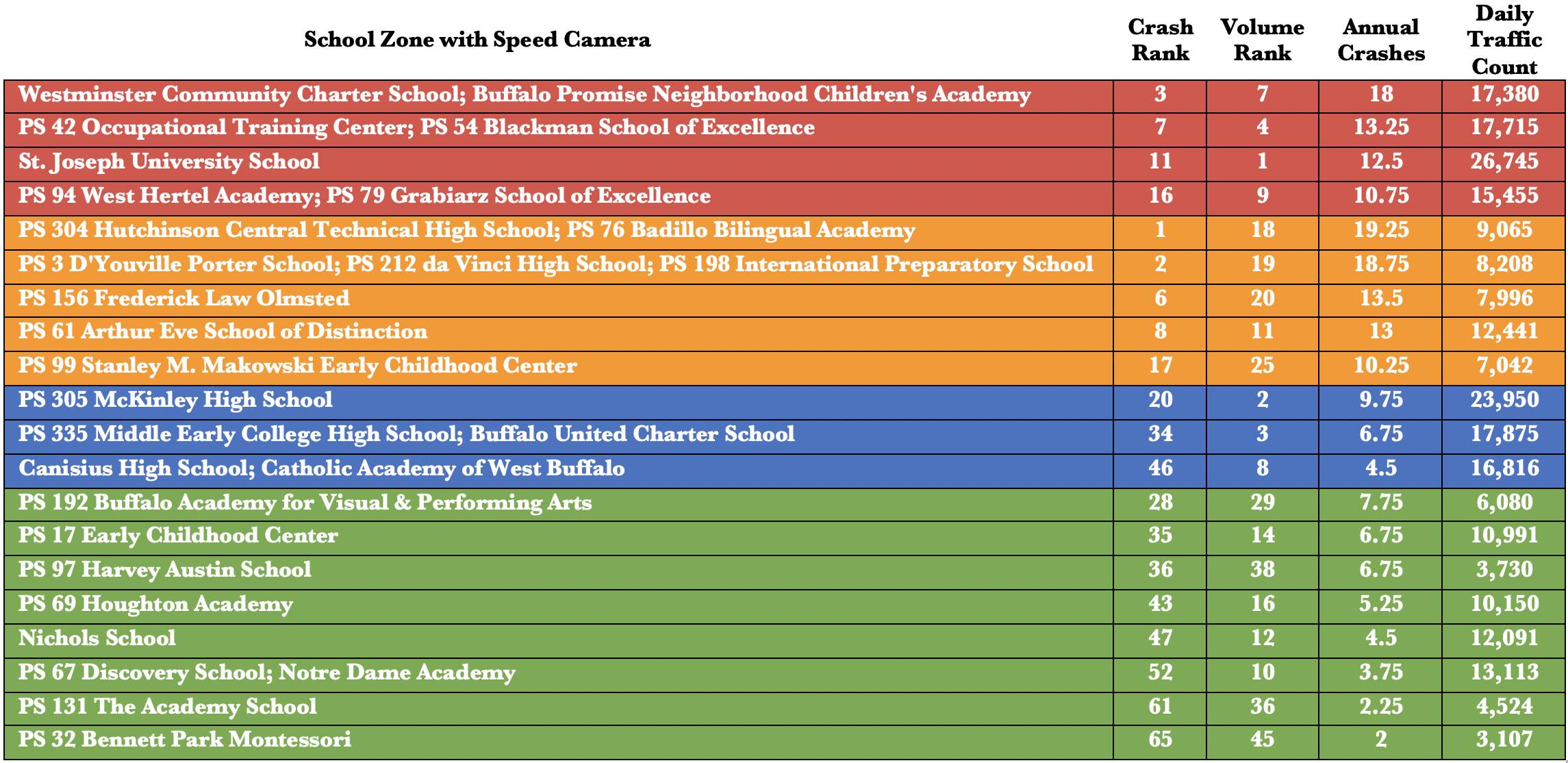 Defining Traffic-Calming Design Improvements
Defining Traffic-Calming Design Improvements
Traffic calming improvements are physical design and other measures put in place on existing roads to reduce vehicle speeds and improve safety for pedestrians and cyclists, according to the Institute of Transportation Engineers. Traffic calming measures typically take two forms, physical or nonphysical. Physical traffic calming typically either reconstructs the street or uses pavement markings; non-physical traffic calming includes education and enforcement (which can use cameras and/or police).
Calming traffic by punitive enforcement can bring negative consequences, from biased enforcement to extraction of wealth from low-income communities overburdened by fines and fees. Physical traffic calming (such as pavement markings or speed bumps), on the other hand, has few negative impacts. By prioritizing physical design changes, traffic safety can be improved without harming residents. Calming traffic by design should be done first, followed by education, with enforcement used as a last resort in areas still experiencing safety issues.
Physical Traffic Calming Design Options
Physical traffic calming by reconstructing a street can be grouped into five categories. Photos and detailed descriptions of each can be found on the U.S Department of Transportation website.
1) Horizontal deflections, including lateral shifts, chicanes, realigned intersections, traffic circles, small modern/mini roundabouts and traditional roundabouts.
2) Vertical deflections, including speed humps, speed cushions, speed tables, raised crosswalks and raised intersections.
3) Street width reduction, such as corner extensions/bulb-outs, chokers, median islands, on-street parking and road diets.
4) Routing restrictions, such as diagonal diverters, closures, median barriers/forced turn islands
5) Traffic signs and pedestrian signals, including stop signs, yield signs, school signs and traffic lights.
As reconstruction and infrastructure projects can be time consuming to plan and implement, many cities are using pavement markings as a low cost and almost immediate option to slow down traffic. Pavement markings include narrowing lanes, painted bike lanes, painted curb extensions, edge lines, painted notices, striped choker or chicane, and striped speed humps.
Recommendations
1. City of Buffalo leaders should end the current demonstration program of the speed cameras. No camera program should be considered until the city invests in traffic-calming infrastructure in each school zone.
2. Each school zone should be individually analyzed for risk based on crash and traffic volume data, and detailed assessments should be made publicly available. The city's engineering team, together with the Bicycle and Pedestrian Advisory Board (BPAB), other transportation organizations, and independent engineers and planners should be part of this assessment.
3. All school zones that have simple needs such as faded or non-existent crosswalks and missing signage should have those basic infrastructure needs addressed immediately.
4. Parents, school staff, administrators, and community members should be engaged in a discussion around traffic safety needs specific to their school. City leaders and Buffalo Public Schools should organize community engagement meetings in every school zone to gather feedback and hear community members' priorities and concerns on traffic safety. With the help of community organizations, transportation experts, and government representatives, these meetings could:
- Present traffic safety data and analysis specific to that school zones.
- Present information on different traffic calming measures that can address these specific safety concerns.
- Allow community members to select the measures they think are the best fit, based on the information presented.
- Produce zone-specific reports on city and school websites, summarizing the findings and selected safety measures.
- Create channels for ongoing communication between residents and city officials throughout the process of improving school zone safety infrastructure. Residents should have multiple ways to provide input and voice priorities and concerns.
5. Based on the public data analysis and expressed wishes of the stakeholders in each school zone, design improvements should be made that materially and significantly improve traffic safety for all road users. Leaders must resist a one-size fits all approach and recognize that each school zone has unique infrastructure needs and considerations.
6. Street infrastructure improvements should be prioritized based on the demonstrated risk posed to students. Zones that are higher risk should be addressed before zones of lower risk. However, low risk zones that do not require expensive improvements should receive regular maintenance--as well as more comprehensive improvements once high-risk zones have been addressed.
7. Funding for design improvements should be allocated during the budget process using federal grant money and by reallocating money from the police budget, since less enforcement will be necessary on streets that are slow by design. Traffic safety measures to slow streets should be a permanent line item in the budget.
8. There should be an annual assessment of traffic calming measures and their impact on school zone safety to ensure current measures are effectively reducing harm, including a review of any devices and enforcement in use. This data should be made publicly available.
9. Based on traffic safety data, city engineers, the BPAB, and city leaders should re-evaluate which zones are still high risk after all design improvements have been made. If speed is demonstrated to be causing a high number of crashes in areas where improvements have already been made, leaders should consult with the community in that school zone about potentially installing a fixed speed camera at that time. If a camera is installed, it must follow New York State and City of Buffalo guidelines. This includes required signage, speed limit, and times for the camera to operate.
The Fair Fines + Fees Coalition believes that investment in street infrastructure should be the rule, and extractive traffic safety measures the exception, when striving to keep our children, pedestrians, and cyclists safe. The recommendations above stem from this principle.
This post was written by Colleen Kristich, Community Researcher at PPG (colleen@ppgbuffalo.org), and Jalonda Hill, Coordinator of the Buffalo Fair Fines + Fees Coalition (jalondah@buffalo.edu).